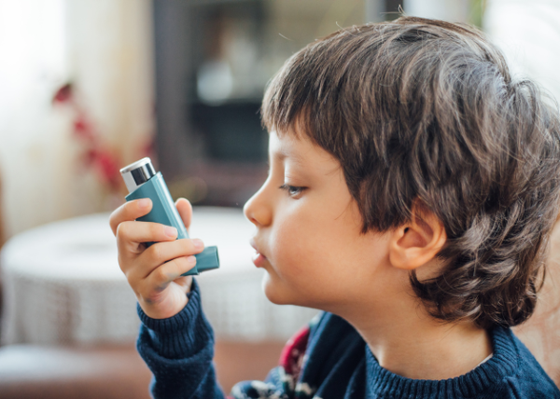About CLARITY
CLARITY is an international research project that addresses a key question on the minds of many pediatricians, infectiologists, pulmonologists and other health professionals: ''Why are children who had an RSV infection in early childhood at increased risk of developing asthma later in life?”
Respiratory syncytial virus (RSV) is a genetically diverse and common respiratory virus that infects nearly all infants before the age of 2 years. While most children recover without complications, in some cases RSV can cause long-term lung problems.
Strong epidemiological studies have shown a link between early RSV infection and the later development of asthma. However, the scientific field still does not fully understand how RSV affects the developing lungs of genetically predisposed children in a way that leads to chronic disease.
In other words, the molecular and physiological mechanisms behind virus-induced asthma remain unclear. This gap in knowledge hinders the development of effective prevention and therapeutic approaches.
What is RSV?
RSV is a virus, and is short for Respiratory Syncytial Virus. It causes a viral infection of the lungs, leading to the inflammation of the smallest lung airways. This is called bronchiolitis. RSV is commonly the cause of bronchiolitis in young children. It affects both infants and older adults, namely RSV is an important cause of pneumonia and other lung problems in older adults.
Our goal uitklapper, klik om te openen
CLARITY aims to unravel the causative link between RSV infection in early life and asthma development in predisposed individuals. By doing so, we aim to identify biological targets for therapy.
Can we prevent acute infection from turning into a life-long lung disease? With CLARITY, we hope to find the answer.

Our research approach uitklapper, klik om te openen
CLARITY brings together clinical and scientific experts and combine their expertise into a highly integrative approach. Molecular biologists, pediatricians, infectiologists, virologists, immunologists, network biologists, biochemists and AI experts are working together to understand how RSV infection interacts with genetic predisposition. To goal is to identify viral and host genetic risk factors and pathways that drive virus-induced asthma.
Human genetics
We will identify human genetic risk factors and RSV strains that contribute to severe bronchiolitis and asthma development. We compare the prevalence of asthma in school-age children, who as infants were hospitalised for RSV-bronchiolitis type A versus B. Data from these children were prospectively collected at admission. Current respiratory status is evaluated through validated asthma questionnaire and lung function tests. To complete the study, we characterize how RSV strains could increase the ability to trigger asthma development, based on both an epidemiological study of seasonal RSV strains and asthma development.
Artificial intelligence
Our researchers use AI-driven methods to analyse how RSV infection affects cells in the lungs. By integrating our data with existing biological knowledge, we aim to map exactly where and how RSV affects lung function. This mapping allows us to generate so-called ‘’perturbation signatures’’, which are biological fingerprints of RSV induced damage. We also aim to identify druglike compounds that could revert the effects of the RSV-induced perturbations.
Organoid models
We validate both the disease mechanisms and compounds for potential treatments in patient derived airway organoid models: miniature lung models that are grown in the lab. These miniature lung models allow us to test whether RSV induced damage can be suppressed by the candidate compounds.
Patient involvement
We actively involve patients in two important ways throughout the project. First, we work with patients who provide respiratory samples that are essential for our virological and laboratory research. Second, we collaborate with patients and caregivers from a social perspective. This means we involve patients in shaping the project, sharing their experiences, and helping us communicate our findings in meaningful ways. The perspectives of patients help us ensure that our work is relevant, impactful and aligned with societal needs. Read more about how we involve patients on the Patients page.

Expected outcomes uitklapper, klik om te openen
- Creating a genetic risk score for the long-term development of virus-induced asthma.
- Tailored prevention campaigns based on genetic risk scores, co-developed with patient groups.
- Knowledge of viruses and the importance of virological surveillance that would detect different infection patterns.
- Identification of molecular mechanisms and compounds that can repair lung damage and that may lead to the development of specific drugs.
Impact uitklapper, klik om te openen
Chronic respiratory diseases, especially asthma and chronic obstructive pulmonary disease (COPD), are a growing burden on society, both in terms of individual suffering and societal costs. In the EU alone, chronic disorders cause major reductions in quality of life and account for an estimated €380 billion in health care and economic costs each year.
The outcomes of CLARITY have the potential to deliver impact at multiple levels:
- Clinical utility: We contribute to improved care and prevention for respiratory diseases by identifying biological mechanisms and treatments.
- Socio-economic value: We aim to reduce disease burden and promote the well-being of patients, their caregivers and the broader public.
- Public awareness: By clarifying the link between RSV and chronic lung disease, we aim to support education and awareness among patients and healthcare professionals. More awareness of this link will ultimately contribute to better prevention and care.

